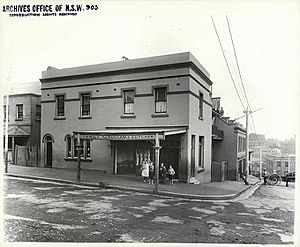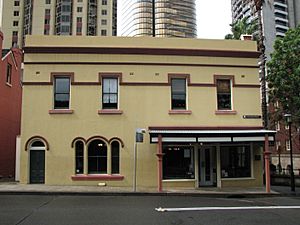Butchery Building facts for kids
Quick facts for kids Butchery Building |
|
|---|---|

J. Duggan, butcher, 178 Cumberland Street, The Rocks, pictured October 1901
|
|
| Location | 178-180 Cumberland Street, The Rocks, City of Sydney, New South Wales, Australia |
| Built | 1890–1899 |
| Owner | Property NSW |
| Official name: Shops and Residences; The Butchery Buildings | |
| Type | State heritage (built) |
| Designated | 10 May 2002 |
| Reference no. | 1593 |
| Type | Terrace |
| Category | Residential buildings (private) |
| Lua error in Module:Location_map at line 420: attempt to index field 'wikibase' (a nil value). | |
The Butchery Building is a special old building in The Rocks, a historic area in Sydney, Australia. It used to be a butcher's shop and homes. Today, it's a heritage-listed restaurant. The building is located at 178-180 Cumberland Street. It was built between 1890 and 1899. It is also known as The Butchery Buildings. The government agency Property NSW owns this property. It was added to the New South Wales State Heritage Register on 10 May 2002. This means it's an important part of the state's history and needs to be protected.
History of the Butchery Building
The Butchery Building has changed over time. Old photos show it once had an awning supported by posts over the shop front. There were also two balconies on the upper floors facing Essex Street. These parts have all been removed.
You can still see signs on the side walls of where other terraced houses once stood. These houses were originally built next to the Butchery Building on Essex Street. They were taken down before World War I to make way for Gloucester Lane. You can also see where these demolished buildings were on the wall of 10-14 Essex Street.
The land where the building stands was first given to James Thompson and Robert Fopp. This happened on 14 May 1836.
What the Building Looks Like
The Butchery Building is made up of two, two-storey buildings. They are made of brick and covered in stucco, a type of plaster. They were built in the late 1880s. You can find them on Cumberland Street, between Essex Street and the Cahill Expressway.
Each building has a basement. This helps with the sloping ground of the area. Number 180 used to have a shop on the ground floor corner. The buildings are built right up against the street. This means their front walls are quite plain.
They are designed in a simple, late Victorian style. They have decorative lines and moldings made of plaster. Number 178 has a special window with three rounded tops on the ground floor. The shop at number 180 has a large display window facing Cumberland Street. This shop front still looks much like it did originally.
Number 180 is interesting because of how it uses its side facing Essex Street. It has an extra space set back from the street. This creates a small back balcony for the upper front room. Below this, there is a private entrance. This leads to stairs that go up to the home, which is separate from the shop.
The inside walls are made of timber frames with lath and plaster. The roof is covered with corrugated iron. The floors and roof frames are made of timber.
These buildings are part of a group of structures on Cumberland Street. They help show what a traditional street in The Rocks looked like in the 20th century.
Building Condition
As of August 2000, the buildings were not being used. They were in a run-down state but were still strong. There were some signs of termite damage in the wooden floors. Also, the beam supporting the front of the shop had some damage.
Changes Over Time
Both buildings are mostly in their original state. Not many big changes have been made. Number 178 Cumberland Street was once used as a restaurant or coffee shop. The wall between two front rooms was opened up. Fake timber beams were added to the ceiling. Wooden strips were also added to the plaster ceilings, possibly in the 1920s. An outdoor toilet was built in the backyard but has since been removed. Number 180 Cumberland Street seems to be almost exactly as it was built, with very few changes.
Why it's a Heritage Site
The Butchery Building is important for its history and scientific value. It also helps show the history of The Rocks area, which is important on its own.
The buildings in this area, including Lilyvale, the Butchery Building, and Harts Buildings, are special as a group. They show how different types of small buildings were developed in The Rocks. This happened between 1840 and World War I. They help us imagine what the lively streets of The Rocks looked like long ago.
The Butchery Building was officially listed on the New South Wales State Heritage Register on 10 May 2002. This means it meets certain rules to be protected.
- It shows the history of New South Wales.
This shop and home, along with its location, are important for their historical and scientific value. They help us understand the past of New South Wales. The building also adds to the historical importance of The Rocks area.
- It shows great design or building skills.
The group of buildings, including Lilyvale, the Butchery Building, and Harts Building, shows how varied small buildings were in The Rocks. They help us see what the busy streets and city life were like in the early 20th century.
Images for kids




